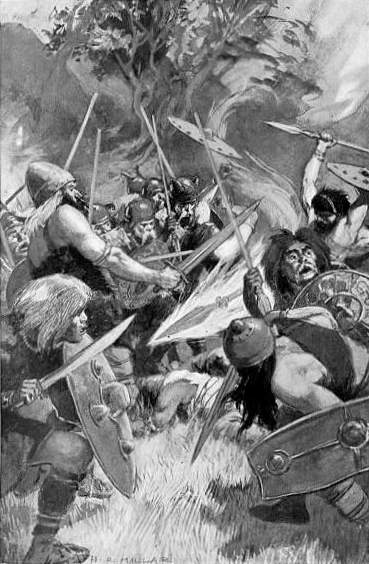|
Conán Mac Morna
Conán mac Morna, also known as Conán Maol ("the bald"), is a member of the fianna and an ally of Fionn mac Cumhail in the Fenian Cycle of Irish mythology Irish mythology is the body of myths indigenous to the island of Ireland. It was originally Oral tradition, passed down orally in the Prehistoric Ireland, prehistoric era. In the History of Ireland (795–1169), early medieval era, myths were .... He is usually portrayed as a troublemaker and a comic figure, fat, greedy and blustering, although he is loyal to Fionn and never runs from a fight. References *Ellis, Peter Berresford, Dictionary of Celtic Mythology (Oxford Paperback Reference), Oxford University Press, (1994): Fenian Cycle {{Celt-myth-stub ... [...More Info...] [...Related Items...] OR: [Wikipedia] [Google] [Baidu] |
Fianna
''Fianna'' ( , ; singular ''Fian''; ) were small warrior-hunter bands in Gaelic Ireland during the Iron Age and early Middle Ages. A ''fian'' was made up of freeborn young men, often from the Gaelic nobility of Ireland, "who had left fosterage but had not yet inherited the property needed to settle down as full landowning members of the ''túath''". For most of the year they lived in the wild, hunting, cattle raiding other Irish clans, training, and fighting as mercenaries. Scholars believe the ''fian'' was a rite of passage into manhood, and have linked ''fianna'' with similar young warrior bands in other early European cultures. They are featured in a body of Irish legends known as the 'Fianna Cycle' or 'Fenian Cycle', which focuses on the adventures and heroic deeds of the ''fian'' leader Fionn mac Cumhaill and his band. In later tales, the ''fianna'' are more often depicted as household troops of the High Kings. The Fenian Brotherhood of the 19th-century and the '' F ... [...More Info...] [...Related Items...] OR: [Wikipedia] [Google] [Baidu] |
Fionn Mac Cumhail
Fionn mac Cumhaill, often anglicised Finn McCool or MacCool, is a hero in Irish mythology, as well as in later Scottish and Manx folklore. He is the leader of the ''Fianna'' bands of young roving hunter-warriors, as well as being a seer and poet. He is said to have a magic thumb that bestows him with great wisdom. He is often depicted hunting with his hounds Bran and Sceólang, and fighting with his spear and sword. The tales of Fionn and his ''fiann'' form the Fianna Cycle or Fenian Cycle (''an Fhiannaíocht''), much of it narrated by Fionn's son, the poet Oisín. Etymology In Old Irish, finn/find means "white, bright, lustrous; fair, light-hued (of complexion, hair, etc.); fair, handsome, bright, blessed; in moral sense, fair, just, true". It is cognate with Primitive Irish ''VENDO-'' (found in names from Ogam inscriptions), Welsh ''gwyn'' (cf. Gwyn ap Nudd), Cornish ''gwen'', Breton ''gwenn'', Continental Celtic and Common Brittonic ''*-'' (a common element in pers ... [...More Info...] [...Related Items...] OR: [Wikipedia] [Google] [Baidu] |
Fenian Cycle
The Fenian Cycle (), Fianna Cycle or Finn Cycle () is a body of early Irish literature focusing on the exploits of the mythical hero Fionn mac Cumhaill, Finn or Fionn mac Cumhaill and his Kóryos, warrior band the Fianna. Sometimes called the Ossianic Cycle after its narrator Oisín, it is one of the four groupings of Irish mythology along with the Mythological Cycle, the Ulster Cycle, and the Cycles of the Kings, Kings' Cycles. Timewise, the Fenian cycle is the third, between the Ulster and Kings' cycles. The cycle also contains stories about other famous Fianna members, including Diarmuid Ua Duibhne, Diarmuid, Caílte mac Rónáin, Caílte, Oisín's son Oscar (Irish mythology), Oscar, and Fionn's rival Goll mac Morna. List of works In the introduction to his ''Fianaigecht'', Kuno Meyer listed the relevant poems and prose texts between the seventh and fourteenth centuriesKuno Meyer. ''Fianaigecht''. xi–xxxi and further examples can be adduced for later ages: ;Seventh centu ... [...More Info...] [...Related Items...] OR: [Wikipedia] [Google] [Baidu] |
Irish Mythology
Irish mythology is the body of myths indigenous to the island of Ireland. It was originally Oral tradition, passed down orally in the Prehistoric Ireland, prehistoric era. In the History of Ireland (795–1169), early medieval era, myths were Early Irish literature, written down by Celtic Christianity, Christian scribes, who Christianized them to some extent. Irish mythology is the best-preserved branch of Celtic mythology. The myths are conventionally grouped into 'List of literary cycles, cycles'. The Mythological Cycle consists of tales and poems about the god-like Tuatha Dé Danann, who are based on Ireland's pagan deities, and other mythical races like the Fomorians. Important works in the cycle are the ''Lebor Gabála Érenn'' ("Book of Invasions"), a legendary history of Ireland, the ''Cath Maige Tuired'' ("Battle of Moytura"), and the ''Aided Chlainne Lir'' ("Children of Lir"). The Ulster Cycle consists of heroic legends relating to the Ulaid, the most important of whi ... [...More Info...] [...Related Items...] OR: [Wikipedia] [Google] [Baidu] |

